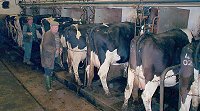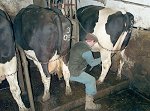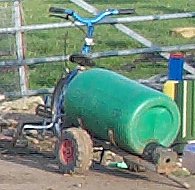

Science Lesson
The process of pasteurisation was invented by the great French scientist, Louis
Pasteur (1822 - 1895). It requires milk to be heated to 72 C for fifteen seconds
and then rapidly cooled to 10 C or lower. Harmful bacteria are killed and the
development of others is delayed.
This process kills the bugs for public safety and helps the milk to keep longer but it also changes the apparent creaminess. Of course, the fat content can not change, but some people think that it loses something else in the process. I have tried both pasteurised and untreated milk together and can't tell the difference.
Milk is also separated using a device which has metal plates spinning at high speed. Centrifugal forces split the cream from skimmed milk. The resulting cream can be re-mixed with the skimmed milk, in the right proportion, to make the semi-skimmed milk.
Ian's bit
Ian Mitchell keeps the milk equipment perfectly clean and within temperature limits. He
also watches over the bottling machine and loads the milk crates into the truck
or the refrigerator. When he isn't doing all of this, he has a very early morning
milk round so that we can have our Weetabix and tea at breakfast time. Unlike most big towns and cities, it is still quite normal to have milk freshly delivered on the doorstep in the Penistone area.
 |
 |
1. Dave tries to mend tractor by prayer. |
Process in Detail
A stainless steel tank cools the incoming milk from the milking shed to about
40 °C. It then goes into a heat-exchanger to warm it up. The following stage
heats the milk to a constant temperature of 72 °C for 15 seconds. It then
goes through the other part of the heat exchanger. This takes up some waste heat
from milk leaving the pasteuriser, to warm up milk going into it. The last part
is the cooler, where the milk is rapidly cooled to 10 °C. The control panel
would look right in a James Bond film. 'Licence to Chill'?
Everything is made from stainless steel and kept scrupulously clean. The whole process also takes a lot of electrical power for the cooling and heating.
UK Milk Bottle Standardisation
The UK has a long tradition of doorstep milk deliveries and I know of at least
three milk rounds who come down my street. Sparrows like to peck their beaks into
the cream of foil-top pint milk bottles. The milk type is indicated by the foil
colour, as in the list below.
Green-top milk is as good as straight from the udder but this untreated milk is hard to come by and is prohibited for schools, hospitals or any public catering. All of the other types listed are pasteurised.
UK milk is also sold in cartons (the dreaded 'tetrapak') and plastic containers but label and top colours are not standardised. Plastic bottles usually have green caps for semi-skimmed and blue for full cream. Another type of milk sold in cartons is UHT long-life milk. This is heated to at least 132 °C for at least one second, giving it a shelf life of months, but - it tastes dreadful in tea. You sometimes come across UHT milk in little plastic sachets which are almost impossible to open without spraying someone.
Many thanks to Dave Stuart and Ian Mitchell at Dyson Coit Farm for this section.